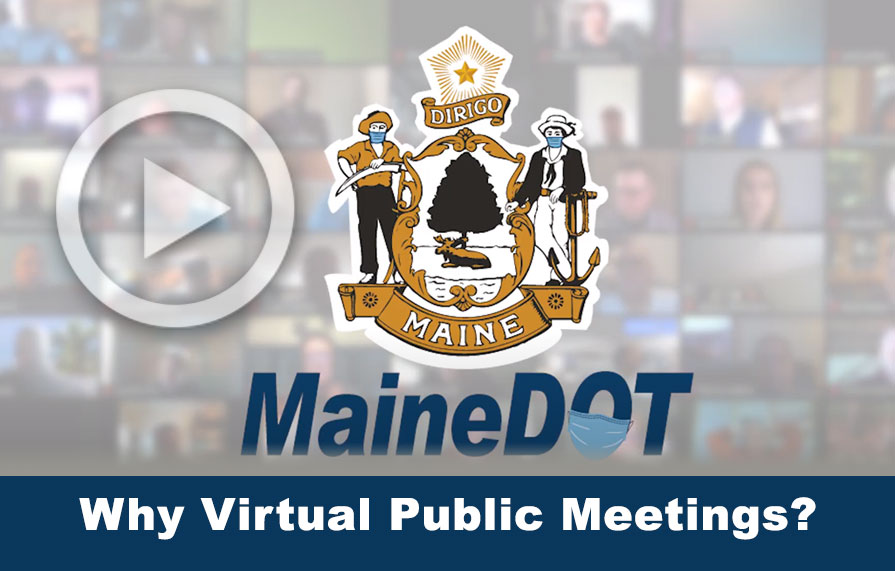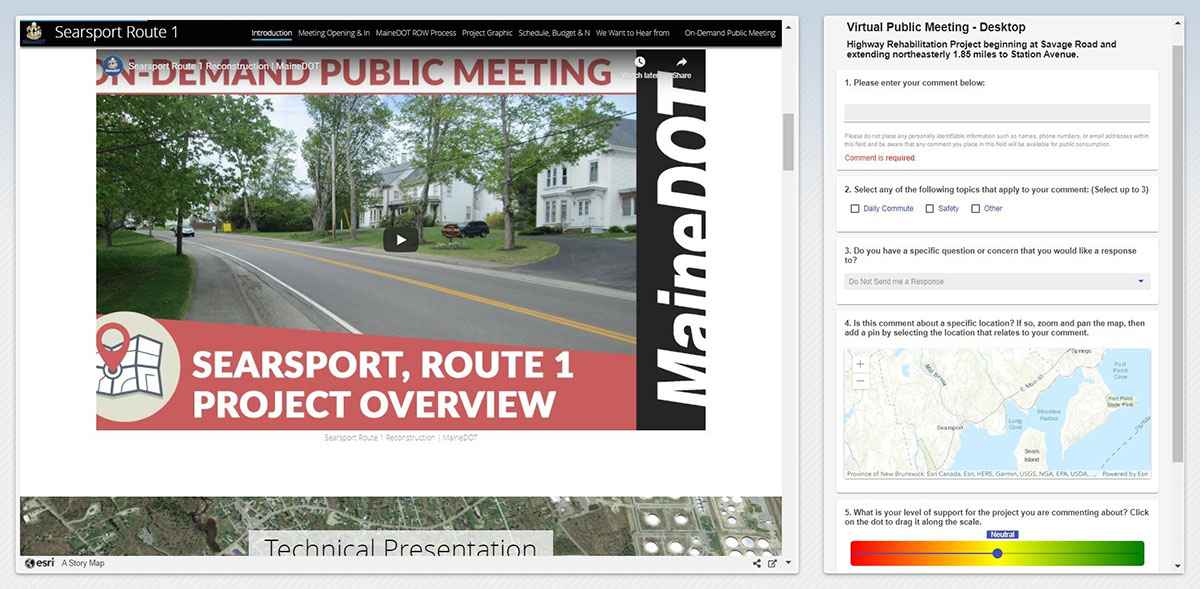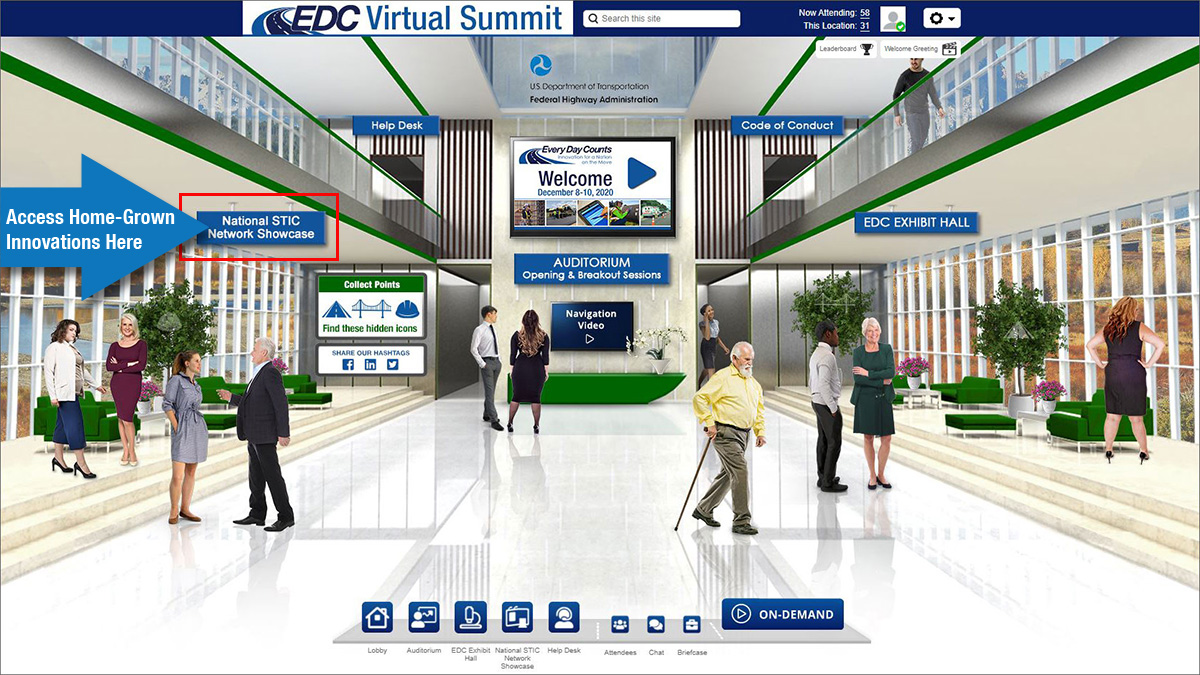June 17, 2021
Innovation of the Month:
Virtual Public Involvement
While many transportation agencies have explored virtual public involvement (VPI) options, recent events have required agencies to accelerate their rate of adoption and use. The Maine Department of Transportation (MaineDOT) officially began participating in the VPI initiative during EDC-5 in 2018. In response to the COVID-19 pandemic, MaineDOT stopped holding in-person public meetings in March 2020 and implemented on-demand virtual public meetings. To date, MaineDOT has completed over 50 virtual meetings and has finalized the incorporation of VPI strategies into their Public Involvement Plan, which can be viewed at this link.

MaineDOT placed an overview video on its website to describe their use of on-demand virtual public meetings as a method for the public to obtain information on transportation projects and to effectively become engaged through this platform to provide comments. Conducting on-demand meetings allows the public to view them at any convenient time. It also does not require travel to a physical location. On-demand public meetings also provide consistent messaging for projects by posting information and leaving it even after the comment period ends.
MaineDOT’s on-demand process includes recording videos of the presentations that would typically be given by the project manager at an in-person meeting then uploading the videos and other documentation helpful for the public to understand the project, into a StoryMap accessed through the MaineDOT website. Depending on the project specifics, the on-demand VPI meeting may include separate video presentations of right-of-way information, and environmental and construction effects. Integration between ArcGIS StoryMaps and the Public Involvement Management Application (PIMA) allows the public to comment from within the StoryMap. The tool can be customized to include specific questions for different projects.
MaineDOT promotes these meetings using social media ads that target the community surrounding a project. Compared to traditional marketing, social media advertisement is inexpensive and allows the project team to choose an area—local, corridor, statewide—or target specific groups. According to MaineDOT, these methods have resulted in significant increases in both the number of people reached and the number of comments received compared to in-person meetings. To date, approximately 2,500 stakeholders have viewed various projects during the On Demand Virtual Public Meeting. Nearly 600 written comments have been provided during on-demand virtual public meetings.

Due to the concern that some in rural communities did not have access to broadband, MaineDOT also provided newspaper and mailed paper notices about their projects that includes the mailing address and telephone number of the project manager in the notice.
Due to the benefits of the on-demand virtual public meetings, MaineDOT will continue to offer these meetings to the public going forward while including the option for having a Live Virtual Meeting and In-Person Meeting in certain circumstances.
To learn more about virtual public involvement, please contact Lana Lau, FHWA Office of Project Development & Environmental Review, Carolyn Nelson, FHWA Office of Project Development & Environmental Review, or Jill Stark, FHWA Office of Planning, Stewardship, & Oversight.
Countermeasures and Safety Action Plans—Two Pillars of the FoRRRwD Approach
The Focus on Reducing Rural Roadway Departures (FoRRRwD) approach is based on four pillars—all public roads, the systemic safety approach, proven countermeasures, and safety action plans (SAPs). In this article, we’ll take a look at proven countermeasures and SAPs.
Although rural roads are extremely diverse, from multilane highways to gravel roads, there are countermeasures demonstrated to fit most situations. For example, while edge line markings are effective at reducing roadway departures, they cannot be installed on gravel or unpaved roads. However, delineators can be used instead on these roads and accomplish a similar goal. FoRRRwD organizes the proven countermeasures around three objectives: keeping vehicles in their lane, reducing potential for crashes when vehicles leave their lane, and minimizing severity if a crash occurs.
Safety action plans are an effective way to prioritize and communicate an agency’s safety needs. SAPs, such as statewide roadway departure action plans or local road safety plans, provide a framework to identify, analyze, and prioritize roadway safety improvements. The process for developing these plans is flexible and can be easily tailored to specific agency issues and needs. Plans can also be a communication tool to explain investment decisions to staff, leadership, and the public. The plans help explain why particular projects need to be done at certain locations and in what order. In addition, a plan may help an agency compete for additional funding in some instances and provides a yardstick to measure agency efforts. FHWA offers agencies a Local Road Safety Plan Do-It-Yourself website, which includes numerous resources and tutorials to help your agency through the process of creating a plan.
To learn more about FoRRRwD, contact Cate Satterfield, FHWA Office of Safety, or Dick Albin, FHWA Resource Center. Read more about these pillars in an article featured in the Winter 2021 Public Roads, and learn more about the first two pillars in the companion article featured in the June 3 edition of EDC News.
Intersection Safety Outreach and Education Products Available
The FHWA Intersection Safety Program is pleased to announce several new outreach and education products to assist State, local, and Tribal partners in advancing intersection safety efforts in their communities.
Two new public service announcements are 30-second audio clips intended for over-the-air or streaming broadcast. They are designed to inform the public about the safety benefits of roundabouts and restricted crossing U-turn (RCUT) intersections, in hopes that when proposed in a community, members of the public will recall that these intersection types are safer. The roundabouts PSA uses a twist on the familiar "The Wheels on the Bus" sing-along, and the RCUT PSA drives home the "RCUTs are cutting" theme of reducing crashes and delay.
To learn more about these and other resources and how they could improve your agency’s safety efforts, please contact Jeff Shaw, FHWA Office of Safety.
Discover Home-Grown Innovations from Around the Country

Are you interested in homegrown innovations being used by your peers in other parts of the country? Check out the National STIC Network Showcase, a component of the EDC-6 Virtual Summit. This site features a convenient one-time registration that will allow you to continue accessing information throughout 2021.
The showcase prominently features several innovations focused on public outreach. Learn about the Caltrans 360 degree interactive project tour, a dynamic and interactive experience designed to help community members and transportation partners visualize project needs and solutions; Delaware bridge project public outreach videos, which help address construction questions and concerns; The City of Ann Arbor, MI's A2 Open City Hall online survey tool, which allows the City to reach more residents than through traditional city meetings, gathers multiple perspectives, and supports more inclusive and accessible public engagement; and the Utah DOT mapping and visualization tools, which use map-based animations to help stakeholders understand how drivers will navigate completed projects.
Celebrate the ingenuity of your peers and read about these innovations—developed and deployed in-house at transportation agencies nationwide. Additionally, we invite you to watch the one-hour presentations on-demand that feature many of these and other innovations.

About EDC
Every Day Counts, a State-based program of the Federal Highway Administration’s Center for Accelerating Innovation, works with State, local, and private sector partners to encourage the adoption of proven technologies and innovations to shorten and enhance project delivery.
Recommended Citation:
U.S Department of Transportation, Federal Highway Administration
EDC News; June 17, 2021
Washington, DC
https://doi.org/10.21949/1521839


